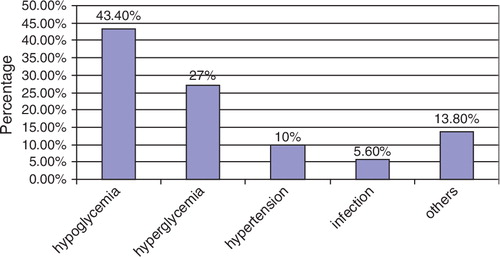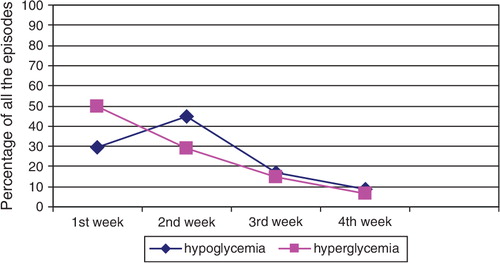Abstract
Background: The epidemiology of diabetes and Ramadan fasting was reported from many Muslim countries, but not from Libya.
Methodology: We interviewed 493 consecutive diabetic patients at Benghazi Diabetes and Endocrine Center for the potential complications of fasting during Ramadan.
Results: We found 70% of diabetic patients completed the 30 days of Ramadan fasting. Hypo- and hyperglycemia was the most commonly reported complications especially during the first two weeks of Ramadan month.
Conclusion: It seems majority of diabetic patients in Libya manage to fast during Ramadan month. Patient education and early planned adjustment of diabetic medication is needed to decrease the frequency of diabetic complication during Ramadan month.
Introduction
Ramadan fasting for diabetics represents a challenge to both patient and physician. The study of epidemiology of diabetes and Ramadan (EPIDIAR study) reported that about 43% of type-1 and 79% of type-2 patients managed to fast a minimum of 15 days Citation1. However, although the study included patients from 13 Muslim countries, it did not involve patients from Libya. In Libya it is estimated that there are about 300,000 diabetics, most of whom are adults who try to observe fasting each year Citation2Citation3. Since culture, educational level and the standards of care vary widely between different Muslim countries, we think that fasting and complication patterns among Libyan diabetics might not be similar to those in other Muslim countries. Moreover, only a few small studies have been done in Libya on diabetes and Ramadan fasting Citation4Citation5.
2 Aims and objectives
The purpose of this study was to define the frequency of fasting and incidence of complications among Libyan diabetic patients during Ramadan.
3 Subjects and methods
Benghazi is the second largest city in Libya with population of about 670,797 inhabitants and 14.1% prevalence rate of diabetes mellitus (DM) Citation6, with type-1 constituting about 6% of all cases. We interviewed and reviewed the records of 493 consecutive diabetic patients who attended the Benghazi Diabetes and Endocrine Center (BDEC) during the first week after Eid Elfitr 1429 Hijri (2008), and a standard form was filled by the authors. The following parameters were assessed: age, sex, type of diabetes, duration of diabetes, type and doses of treatment before and during Ramadan, level of HbA1c within three months before Ramadan, number of non-fasted days, causes of breaking the fast, number and time of self-reported hypo- and hyperglycemic episodes, and any history of hospital admission during the preceding Ramadan and the reason for it.
Hypoglycemia was defined as symptoms that were perceived by the patient as hypoglycemia and urged him/her to break fast with or without documented low blood glucose, and it was categorized as severe or mild. A severe hypoglycemic episode was defined as the episode that could not be treated by the patient alone, but required assistance from another person, whether a physician or not. Mild hypoglycemia was defined as a hypoglycemic episode that was treated by the person with diabetes alone without need for assistance. Severe hyperglycemia was defined as a self-reported blood glucose level ≥300 mg/dl.
3.1 Statistics
Data were expressed as mean±standard deviation (SD) and differences between groups were tested using the Chi-squared test and independent-samples t-test.
Differences were considered significant when the P-value was <0.05.
4 Results
Of the 493 patients, 95% were type-2 diabetics, 50.3% were males and 39% had their HbA1c checked within three months before Ramadan. Mean age was 59±11.7 years, mean duration of diabetes was 11.3±10 years, and mean HbA1c (for those who had HbA1c results) was 7.8±1.6. About 27% of the patients had no treatment changes during Ramadan fasting. The mean number of fasted days was 28.5±4.6 days. About 70.4% of patients completed 30 days of fasting and 97.5% fasted at least 15 days (). The main reason of breaking the fast was hypoglycemia (43.4% of causes) followed by severe hyperglycemia (27%), while other causes constituted about 30% (). About 14.6% experienced mild hypoglycemia, 3.2% had severe hypoglycemia and 11.2% had severe hyperglycemia. Only 5.1% were admitted to hospital during the study period (). There was no significant difference between type-1 and type-2 diabetics regarding number of days fasted, frequency of hypoglycemia or severe hyperglycemia, or admission rate during Ramadan (). Among type-2 diabetic patients during Ramadan fasting, 77.3% were on insulin therapy, 20.5% were on oral anti-diabetics, and 2.2% were on diet control alone. There was no significant difference between those who were treated with insulin or with oral anti-diabetic agents in the mean HbA1c, mean number of fasted days, admission rate or incidence of hypoglycemia, or severe hyperglycemia ().
Fig. 1. Percentage of causes of breakfasting during Ramadan.

Table 1. General characteristics of the study group
Table 2. Comparison between type-1 and type-2 diabetics
Table 3. Comparison between type-2 patients according to the type of treatment
The incidence of hypoglycemia during Ramadan was 31 episodes/100 patients, while the incidence of severe hyperglycemia was 17 episodes/100 patients (). About 74% of hypoglycemic episodes and 79% of hyperglycemic episodes occurred during the first two weeks of Ramadan (), and about 90% of all hypo- and hyperglycemic episodes occurred during the daytime. Females had a significantly higher frequency of severe hypoglycemic episodes (4.9% vs. 1.6%, p=0.04) and a lower mean number of fasting days than males (27.8±5.9 vs. 29.24±2.6, p=0.001). Patients who experienced severe hyperglycemia had a significantly higher baseline HbA1c than other patients (8.4±1.1% vs. 7.6±1.6%, p=0.02). They also had a significantly lower mean number of fasting days (26.9±5.7% vs. 29±4, p=0.001).
Fig. 2. Time trend of hypoglycemia and hyperglycemia during Ramadan.

Table 4. Incidence of acute glycemic derangement
5 Discussion
Both type-1 and type-2 diabetic patients in Benghazi managed to fast more frequently than diabetics in other Muslim countries, with a remarkably lesser frequency of hypo- and hyperglycemia (). It is possible that Libyan diabetics are more motivated to fast than those in other Muslim countries. More likely, however, is that about three-quarters of the Libyan patients had some treatment adjustment during Ramadan as compared to less than one-third of those in the EPIDIAR study Citation1, which probably contributed to the lower rate of hypo- and hyperglycemia, and hence to a lower frequency of breaking the fasting.
Table 5. Comparison between BDEC study and EPIDIAR study
The most common complications that occurred during Ramadan were hypoglycemia followed by hyperglycemia, and these were the main two reasons for breaking the fast, as reported elsewhere Citation1. However, both types of episodes were remarkably less frequent during the last two weeks as compared to the first two weeks, perhaps because patients adjust their dietary habits and schedules to suit their condition as the days go by.
The definition of hypoglycemia used in this study depended mainly on patients’ perception of symptoms, which means that in principle episodes of hypoglycemia might go unnoticed. However, patients are probably unlikely to miss feeling a hypoglycemic episode because it would become exacerbated as the fasting continued during the day. On the other hand, we might have included some non-hypoglycemic episodes that were interpreted as hypoglycemia by the patients. Therefore, we believe that the reported figure of the frequency of hypoglycemic episodes might be a slight overestimate rather than an underestimate of the frequency of these episodes.
There was no significant difference between type-1 and type-2 diabetics regarding fasting rate, admission rate and frequency of hypo- and hyperglycemic episodes during Ramadan. These results are contrary to the reported higher risk of complications in type-1 patients during Ramadan fasting Citation7. The mean HbA1c in type-1 patients was 8.2±1.7%, which is above the currently recommended goal of <7%. If type-1 patients had a strict glycemic control with mean HbA1c level lower than 7%, it would be more likely that they will get a more frequent hypoglycemic episodes. Nevertheless the number of type-1 diabetics in this study was too few to draw conclusions.
6 Conclusion
Most type-2 diabetic patients in Libya managed to fast during Ramadan. Patient education and adjustment of doses throughout Ramadan is needed to decrease the risk of both hypo- and hyperglycemia. Further large studies are needed to study the effects of Ramadan fasting on type-1 diabetic patients in Libya.
7 Conflict of interest and funding
The authors have not received any funding or benefits from industry to conduct this study.
Acknowledgements
Authors thank BDEC for sponsoring this research work.
References
- Salti I, Benard E, Detournay B, Bianchi-Biscay M, Le Brigand C, Voinet C, et al.. EPIDIAR study group, a population based study of diabetes and its characteristics during the fasting month of Ramadan in 13 countries: results of the epidemiology of diabetes and Ramadan 1422/2001 (EPIDIAR) study. Diabetes Care. 2004; 27: 2306–11.
- Bakoush O, Elgzyri T. Do we have a diabetes epidemic in Libya?. Libyan J Med. 2006; 1: 123–5.
- Alshkri MM, Elmehdawi RR. Metabolic syndrome among type-2 diabetic patients in Benghazi–Libya: a pilot study. Libyan J Med. 2008; 3: 177–80.
- Kadiki OA, Moawad SE, Khan ZA, Reddy MRS, Marzoug AA. Diabetes mellitus and Ramadan. Garyounis Med J. 1989; 12: 32–4.
- Abusrewil SS, Turki HM, Osman F, Kabuka M, Mgadmi A. Ramadan fasting and diabetic control in adolescents and young Adult. JMJ. 2003; 2: 49–50.
- Kadiki OA, Roaeid RBM. Prevalence of diabetes and impaired glucose tolerance in Benghazi Libya. Diabetes Metab. 2001; 27: 647–54.
- International Meeting on Diabetes and Ramadan Recommendations: Edition of the Hassan II Foundation for Scientific and Medical Research on Ramadan. Casablanca, Morocco, FRSMR, 1995.